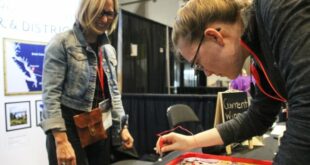Jennifer Green is driving to farms across the province, hoping to drive the growth of an industry.

Jennifer Green makes it look easy — grabbing a handful of dried flax stalks and beating away the rough outer casing to reveal long, soft, golden strands of fibre that can be spun and woven into linen.
But when a group of first-timers try to copy her, it becomes apparent that processing flax is a skill that requires deep knowledge and lots of practice. Green has both, and is on a mission to share them across the province.
“My vision is for a local Nova Scotian linen industry,” she said.
Last year, Green set out to help local farmers grow and process flax. She’s tapped into grants from Research Nova Scotia, Arts Nova Scotia and the provincial government to pay for the work, which so far includes 21 farms scattered between the South Shore and the Margaree Valley of Cape Breton.
She travels around the province in a cargo van, dubbed the Flaxmobile, to meet farmers on their land and teach them the ins and outs of flax production.

Green was driven to start her project through her experience as a textile designer. She’s also an associate professor of textiles and fashion at NSCAD University.
She said the lack of local materials is a roadblock for craftspeople in Nova Scotia because of the cost of importing from abroad.
“Not to mention,” she added, “if you’re really trying to make objects that evolve from your culture and place, it’s hard to be using yarns or materials from elsewhere to be telling those stories.”
Farmers on board
She said farmers have been keen to join, hoping to diversify their crops, and participate in the development of a flax and linen industry.
“They’re very aware of the local food movement and so the idea of a local textiles movement is really intriguing to them.”
One of the farms involved is The North Grove, which is run by a non-profit organization and its volunteers in the north end of Dartmouth.

Katherine Carey, the farm’s co-ordinator, said it would not have been possible to start the crop at the urban farm without Green’s help.
“There’s not a ton of information online,” said Carey. “The books that [Green] uses, they’re out of print. You can’t find them. So a lot of the knowledge is — you have to know people, you have to form those relationships.”
The North Grove’s flax plot measured about three metres by three metres, and Carey said she intends to replant on a similar scale next year.
Craftspeople paired with farms
Some of what The North Grove grew and processed will go to Frances Dorsey, who has been a textile artist for more than 40 years.
Dorsey said she’s “thrilled” to see a revival of flax production in Nova Scotia.

“I like the quality of the fibre. I like the strength of the fibre. I like the way that it takes colour. I like the way that something made of linen has a particular kind of weight and gravity and hang,” she said. “And I like it because it’s environmentally sound.”
Dorsey said she’ll use some of the fibres for weaving, and some for experimenting with creating coiled baskets.
Green introduced Dorsey to The North Grove. It’s something she aims to do with all the farmers she works with — connect them with craftspeople who are interested in using the flax.
The idea, she said, is to establish networks across the province, “so that we can try to develop a more flourishing industry.”
Revitalizing a Nova Scotia tradition
Green said flax was a common crop in Nova Scotia in the 18th and 19th centuries, used by settlers to make linen clothing, but it dwindled in the 1900s. Now, Green is trying to create a flax renaissance.
Some of the hand tools she uses are replicas of those used by local farmers hundreds of years ago. She teaches growers how to extract the flax fibre from the plant using hand tools because, she said, it’s the best way to learn.
“We process it by hand so that they really understand — was it harvested at the right time?” Green said. “Is it giving a good yield and quality in the final product?”
But after the first year, the flax is processed mechanically at a facility in the Annapolis Valley that’s run by TapRoot Farms, cutting down on time and labour, and making it possible for the farmers to scale up.
Green said she hopes to see flax production reach a commercial scale in Nova Scotia within a decade.
Challenges to scaling up
Caitlin Congdon, a field crops specialist with Nova Scotia Crown corporation Perennia, said flax as a crop is an “interesting opportunity,” but it presents challenges on a commercial scale.
Flax needs acidic soil, unlike many other local crops, making it difficult to include in crop rotations, according to Congdon. Most local farms would also have to make a significant investment in machinery to get started in large-scale flax farming, she said.
Green agreed there are impediments to scaling up, but she did not think they were insurmountable. Overcoming those challenges, she said, is essentially the point of her project.

Reporter
Taryn Grant is a Halifax-based reporter and web writer for CBC Nova Scotia. You can email her with tips and feedback at taryn.grant@cbc.ca
*****
Credit belongs to : www.cbc.ca
 Atin Ito First Filipino Community Newspaper in Ontario
Atin Ito First Filipino Community Newspaper in Ontario






